Executive Summary
| Disclaimer: Links within the texts to additional information, concepts and tools are SSWM editor’s inputs and might not represent the view or practices of GIZ. |
Introduction
The status report, which shows the current situation of the infrastructure and service provision of water and sanitation, serves as a base for the formulation of a strategy at city level for the achievement of the National Urban Sanitation Policy (NUSP) vision. The plan for improving sanitation in each city should be prepared in collaboration with the CSTF and the officials of the ULB, in order to identify priorities, challenges and resources to come up with action plans that are feasible and reflect the needs of the city. Within the GIZ Programme to support the implementation of the NUSP (see GIZ Support to the NUSP), GIZ and partners formulated a strategy to prepare recommendations and actions plans in the six selected cities: Shimla, Varanasi, Nashik, Raipur, Kochi and Tirupati (see also case studies Raipur and Kochi). The following methodology could also be adapted and used by other institutions to formulate their action plans.
Methodology
The strategy formulated by GIZ and partners is based on the five strategic dimensions for holistic planning, namely: Governance and Institutional Strengthening, Finance, Capacity Enhancement, Technology and Inclusiveness.
Five strategic dimensions to achieve sustainable city-wide sanitation. Source: S. PUVAR (2013) adapted from DUBE (2012)
The status report prepared in a previous step will contain the current state of the sanitation components in a given city:
- Water supply (e.g. percentage of people with access to piped water)
- Access to toilets (e.g. number of people with access to private toilet)
- Wastewater management (e.g. m3 of wastewater treated)
- Storm water management (e.g. km of storm water channels in place)
- Solid waste management (e.g. % of population with door-to-door-collection)
All these figures are evaluated in a participatory approach using the Service Level Supply Benchmarking of the Government of India, and considering their sustainability based on the five strategic dimensions.
The following steps are then followed to make recommendations and action plans in each city (adapted from RMC 2011).
Definition of the City-Level Goals
(Adapted from RMC et al. 2011)
In collaboration with the CSTF and the ULB officials, a vision should be defined for each of the sanitation components identified above: water supply, access to toilets, wastewater management, storm water management and solid waste management. These visions will serve as reference for future actions and help to visualise the city’s aspirations regarding to each of the components. Just to give an example, the following statements show the visions of the city of Tirupati for water supply and access to toilets (MCT et al 2011):
- “Achieve water security through provision of equitable and efficient access to continuous piped potable quality water supply in a financially environmentally sustainable manner”.
- “Eliminate open defecation through provision of equitable and efficient access to public and community toilet access and by making all citizens sanitation-conscious through sustained awareness efforts”.
Once the visions are defined, city level goals are to be identified following the NUSP guidelines. It is recommended to define goals for each of the sanitation components, defining parameters that will allow monitoring their achievement. The timeline for short, medium and long-term goals should be identified in collaboration with the respective Municipal Corporation. This allows having a time reference to monitor the achievement of the objectives. For Shimla for instance, the following time frames were identified: short-term (2013-2021), mid-term (2021-2031) and long term (2031-2041). In Tirupati, on the other hand, two different time horizons were defined: (1) a planning horizon (30 years 2012-2041) consistent with the typical time frames for planning infrastructure asset creation and (2) an action horizon (10 years 2012-21) defined specific for the actions recommended. This action time horizon was further divided into actions at short term (3 years), medium term (5 years) and long term (10 years).
The following table shows an example of targets for wastewater management for Tirupati, that were established following the Service Level Benchmark of the Government of India:

Wastewater management: short, medium and long-term targets. Source: MCT & GIZ (2011)
Identification of City Level Key-Issues
(Adapted from RMC et al. 2011)
Critical issues concerning water supply, wastewater management, solid waste management, access to toilets and storm water drain systems should be identified and the most pressing problems are to be classified as “City Level Key Issues”. Inclusiveness should be a guiding framework when selecting these key issues, to take into account the special needs of vulnerable groups, such as women, children and elderly.
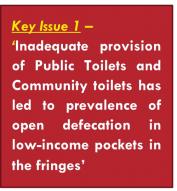
Key Issue 1 in Tirupati. Source: MCT et al. (2011)
The box in the left shows the Key Issue 1 identified in the city of Tirupati, which deals with the inadequate provision of public toilets and community toilets in low-income pockets in the fringes. This example shows how inclusiveness should be the reference when identifying key issues, to ensure that the poor also benefit from the resources assigned to improve the sanitation of a city as well as other implementation initiatives of the CSP.
In order to ease the understanding of the current sanitation issues, the city should be divided in different clusters, such as ward level, zone level or economic levels (urban and urban poor). “The idea of clustering is to identify those areas, wards and locations within the city with similar issues, which can be equally dealt with in the recommendations section. The boundaries for a cluster could be defined differently such as: land ownership, socio-economic factors, built-form, natural boundaries (urban watersheds), sanitation infrastructure, land-use or pollution hotspots” (GIZ 2010).
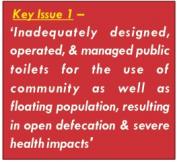
Key Issue 1 in Shimla. Source: SMC et al. (2011)
In order to take immediate actions and plan for solutions, each expert team should define individually the clusters and boundaries in each city. The following picture shows the identification of a cluster for the key issue 1 identified in Shimla. Here the numbers refer to the ward numbers, and they are classified depending of the type of toilet facilities (or in case there are not facilities, OD: open defecation) that are characteristic of the area:
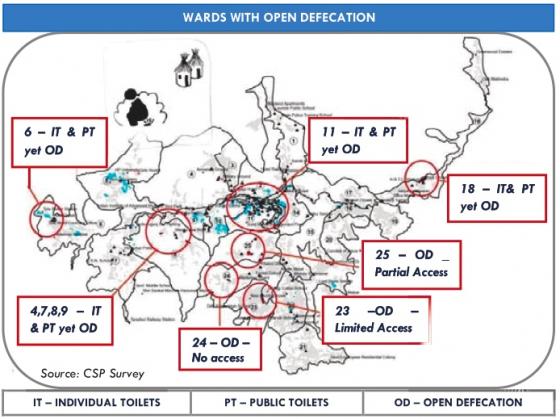
Example of identification of clusters with similar key issues identified. Source: SMC et al. (2011)
Key issues are not merely technical, and analysing the situation considering the “five strategic dimensions to achieve sustainable city-wide sanitation” will help to identify the true problems of the service delivery, and not the superficial consequences. The case studies for Raipur and Kochi present 10 key issues identified by the CSP team in each of the city. The following 3 issues are taken from the Executive Summary of the CSP of Nashik (NMC et al. 2011):
- “Prevalence of open defecation in slums and around religious areas and open urination at public places.
- Existing septic tanks could create potential risks of ground water pollution and affect public health and utilisation of Sewage Treatment Plants (STPs).
- Lack of information on wastewater volume flows and non-automated sewerage system”.
Every key issue should be accompanied by a rationale that explains the findings of the status report and justifies their selection. Considering that the CSP will be a guiding and working document for ULB authorities and officials, it is of key importance to offer them facts to make informed choices when planning for water and sanitation.
Recommendations for Key Issues
(Adapted from RMC et al. 2011)
Once the key issues are identified, context-specific solutions are designed in terms of technology required, costing, institutional and governance enhancement, community awareness and inclusiveness (COC et al. 2011) (see also sanitation systems, financing, creating an enabling environmentand awareness raisingin wastewater collection). “It is important to find an approach of delivering recommendations that are appealing and synchronised to the ideas of the councillors in order to keep sanitation in the top priority of the local political agenda. The CSP recommendations should also link to the State Sanitation Strategies” (GIZ 2011).
The recommendations can also be prepared for each sector, packaged along the following hierarchy (RMC et al. 2011): immediate actions directives, directives to strengthen baseline information, directives for feasibility studies and directives towards detailed project reports. The following figure shows an example of recommendations for access to toilets for the city of Shimla:
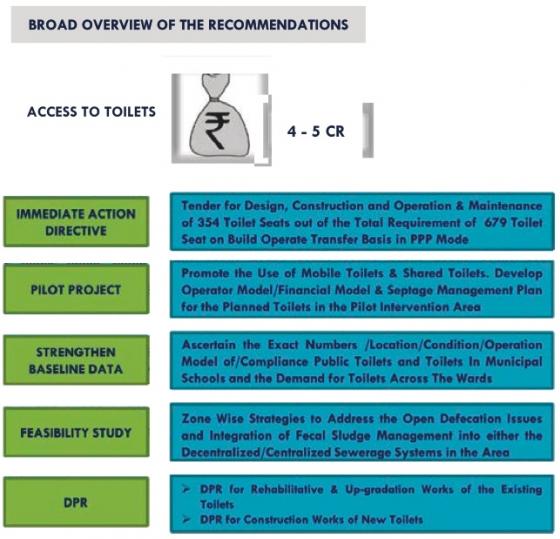
Broad overview of the recommendations for access to toilets for Shimla. Source: SMC et al. (2011)
The institutional barriers in each of the technical issues should be dealt individually in order to harmonise the process of planning, implementation, operation and maintenance, and monitoring.
The CSP experts will identify additional areas where there is a need for further detailed studies (Detailed Project Reports, DPRs),supported by relevant documentation justifying the need for such studies within the scope of the CSPs.
Action Plans
(Adapted from RMC et al. 2011)
Action plans are time-bounded actions based on the above given recommendations that will be carried out to achieve the goal of 100% sanitised city. Within the action plans the experts, in collaboration with the ULBs and the CSTF, will prioritise the key issues that have to be addressed on an immediate, short, medium and long term basis.
“These action plans are designed across the five plan components (access to toilets, wastewater management, river pollution and storm water management, water supply, solid waste management), and major strategic support components (governance and institutional framework and financial sustainability). These action plans are packaged around five strategic dimensions of intervention: technology, finance, institution and capacity building, governance and inclusiveness” (COC et al. 2011) (see also sanitation systems, financing, invalid link and invalid link). The following figure presents the action plans that should be described in a City Sanitation Plan:
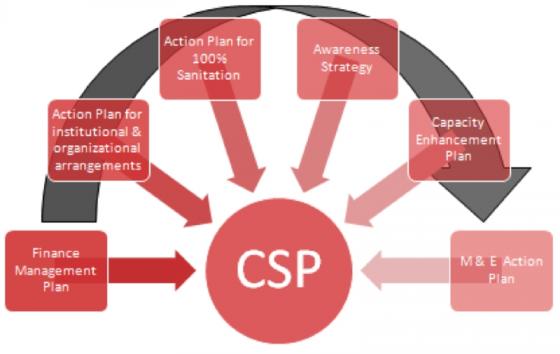
Components of the action plan for the achievement of 100% sanitised city. Source: GTZ (2010, Developing a Framework)
The awareness strategy plan is one of the most important components of the CSP, as it brings the citizens on board in the task of achieving the objectives of the NUSP (see also awareness raising in wastewater collection). Though the CSP will recommend an awareness generation strategy for various target groups in the city, there is a need to identify key institutions (like local universities, active groups and NGOs) to carry out the awareness generation activities as detailed in the CSP recommendations.
The following diagram shows the action plan designed for Shimla in 4 different phases: immediate, short, medium and long term. The actions are grouped in different strategic dimensions: technology, institutional and governance, capacity enhancement and community awareness and inclusiveness.
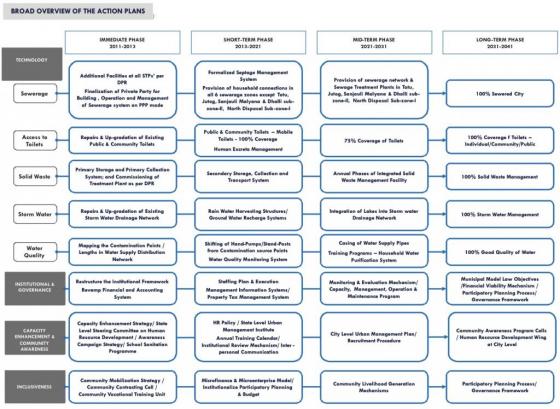
Broad overview of the key milestones in action plans for Shimla. Source: SMC et al. (2011)
City Sanitation Plan for Kochi
This Brochure is a succinct overview of the City Sanitation Plan for City of Nashik in order to recognise the stress areas in the sanitation sector and establish priorities in the intervention areas along the defined strategic guidelines.
KMC GIZ IMACS (2011): City Sanitation Plan for Kochi. New Delhi: Municipal Corporation Nashik in cooperation with GIZ and ICRA Management Consulting Services Limited (IMaCS) URL [Accessed: 05.11.2012]Report on Mid-Term Workshop on the preparation of the City Sanitation Plans. 5th July 2010
This report contains the results of the workshop on preparing the City Sanitation Plans (CSP) with the CSP consultants of the respective cities. The objectives of the workshop were discussing the status of the baseline data collection in the respective cities, identifying data gaps, identifying the issues in the preparation of the CSP and discussing and streamlining the CSP outputs.
GTZ (2010): Report on Mid-Term Workshop on the preparation of the City Sanitation Plans. 5th July 2010. Eschborn: Deutsche Gesellschaft fuer Technische Zusammenarbeit (GTZ)Report of the Workshop on Developing a Framework for the preparation of the City Sanitation Plans. 29th September 2010 in New Delhi
This report contains the results of the workshop on developing a framework for the preparation of the CSPs conducted by GTZ with the CSP consultants for the cities. The objectives of the workshop were discussing the key issues in the status reports, identifying data gaps, discussing the issues in ensuring ownership at ULB/State level and developing a framework for the CSP outputs/recommendations.
GTZ (2010): Report of the Workshop on Developing a Framework for the preparation of the City Sanitation Plans. 29th September 2010 in New Delhi. Eschborn: Deutsche Gesellschaft für Technische Zusammenarbeit (GTZ)Report of the Workshop on “Draft City Sanitation Plan”. 7th and 8th April 2011 in New Delhi
This report contains the results of the workshop on the draft City Sanitation Plans (CSPs) with the CSP consultants of the respective cities. The objectives of the workshop were discussing the structure of the CSP recommendations and discussing and finalising the deadlines for the submission of the draft CSPs.
GIZ (2011): Report of the Workshop on “Draft City Sanitation Plan”. 7th and 8th April 2011 in New Delhi. Eschborn: Deutsche Gesellschaft fuer Technische Zusammenarbeit (GTZ)Draft City Sanitation Plan. Main Report
Draft City Sanitation Plan for Kochi
GIZ is supporting various cities in the preparation of City Sanitation Plans (CSPs) under the National Urban Sanitation Policy (NUSP) formulated by the Ministry of Urban Development (MoUD), Government of India (GOI) in 2008. This summary contains city level key issues for Kochi.
GIZ (2011): Draft City Sanitation Plan for Kochi. Executive Summary. New Delhi: Municipal Corporation of Kochi in cooperation with GIZ and ImaCS URL [Accessed: 31.10.2012]City Sanitation Plan for Raipur
This Brochure is a succinct overview of the City Sanitation Plan for City of Raipur in order to recognise the stress areas in the sanitation sector and establish priorities in the intervention areas along the defined strategic guidelines.
RMC GIZ CDD (2011): City Sanitation Plan for Raipur. Raipur: Municipal Corporation Raipur in cooperation with GIZ and Consortium for Dissemination of DEWATS URL [Accessed: 06.11.2012]City Sanitation Plan for Shimla
This Brochure is a succinct overview of the City Sanitation Plan for City of Shimla in order to recognise the stress areas in the sanitation sector and establish priorities in the intervention areas along the defined strategic guidelines.
SMC GIZ DCC (2011): City Sanitation Plan for Shimla. Shimla: Municipal Corporation Shimla in cooperation with GIZ and Consortium for Dissemination of DEWATS URL [Accessed: 06.11.2012]Report on Mid-Term Workshop on the preparation of the City Sanitation Plans. 5th July 2010
This report contains the results of the workshop on preparing the City Sanitation Plans (CSP) with the CSP consultants of the respective cities. The objectives of the workshop were discussing the status of the baseline data collection in the respective cities, identifying data gaps, identifying the issues in the preparation of the CSP and discussing and streamlining the CSP outputs.
GTZ (2010): Report on Mid-Term Workshop on the preparation of the City Sanitation Plans. 5th July 2010. Eschborn: Deutsche Gesellschaft fuer Technische Zusammenarbeit (GTZ)Report of the Workshop on Technical Recommendations for the City Sanitation Plans, 10th December 2010
This report contains the results of the workshop on identifying the technical recommendations for the preparation of the City Sanitation Plans (CSPs). The objectives of the workshop were among others discussing the strategy for ward proposals and awareness campaigns, the utilisation of the tools for data interpretation and subsequent recommendations and discussing the available technical options for improving the sanitation situation in the cities.
GTZ (2010): Report of the Workshop on Technical Recommendations for the City Sanitation Plans, 10th December 2010.Report of the Workshop on “Draft City Sanitation Plan”. 7th and 8th April 2011 in New Delhi
This report contains the results of the workshop on the draft City Sanitation Plans (CSPs) with the CSP consultants of the respective cities. The objectives of the workshop were discussing the structure of the CSP recommendations and discussing and finalising the deadlines for the submission of the draft CSPs.
GIZ (2011): Report of the Workshop on “Draft City Sanitation Plan”. 7th and 8th April 2011 in New Delhi. Eschborn: Deutsche Gesellschaft fuer Technische Zusammenarbeit (GTZ)City Sanitation Plan for Shimla
This Brochure is a succinct overview of the City Sanitation Plan for City of Shimla in order to recognise the stress areas in the sanitation sector and establish priorities in the intervention areas along the defined strategic guidelines.
SMC GIZ DCC (2011): City Sanitation Plan for Shimla. Shimla: Municipal Corporation Shimla in cooperation with GIZ and Consortium for Dissemination of DEWATS URL [Accessed: 06.11.2012]City Sanitation Plan for Raipur
This Brochure is a succinct overview of the City Sanitation Plan for City of Raipur in order to recognise the stress areas in the sanitation sector and establish priorities in the intervention areas along the defined strategic guidelines.
RMC GIZ CDD (2011): City Sanitation Plan for Raipur. Raipur: Municipal Corporation Raipur in cooperation with GIZ and Consortium for Dissemination of DEWATS URL [Accessed: 06.11.2012]City Sanitation Plan for Tirupati
This Brochure is a succinct overview of the City Sanitation Plan for City of Tirupati in order to recognise the stress areas in the sanitation sector and establish priorities in the intervention areas along the defined strategic guidelines.
TMC GIZ IMACS (2011): City Sanitation Plan for Tirupati. Tirupati: Municipal Corporation Tirupati in cooperation with GIZ and ICRA Management Consulting Services Limited (IMaCS) URL [Accessed: 06.11.2012]City Sanitation Plan for Kochi
This Brochure is a succinct overview of the City Sanitation Plan for City of Nashik in order to recognise the stress areas in the sanitation sector and establish priorities in the intervention areas along the defined strategic guidelines.
KMC GIZ IMACS (2011): City Sanitation Plan for Kochi. New Delhi: Municipal Corporation Nashik in cooperation with GIZ and ICRA Management Consulting Services Limited (IMaCS) URL [Accessed: 05.11.2012]City Sanitation Plan for Nashik
This Brochure is a succinct overview of the City Sanitation Plan for City of Nashik in order to recognise the stress areas in the sanitation sector and establish priorities in the intervention areas along the defined strategic guidelines.
NMC GIZ IMACS (2011): City Sanitation Plan for Nashik. Nashik: Municipal Corporation Nashik in cooperation with GIZ and ICRA Management Consulting Services Limited (IMaCS) URL [Accessed: 06.11.2012]http://www.susana.org/
This website contains the City Sanitation Plans in India (at the moment Nashik, Kochi, Raipur, Shimla, Tirupati).

